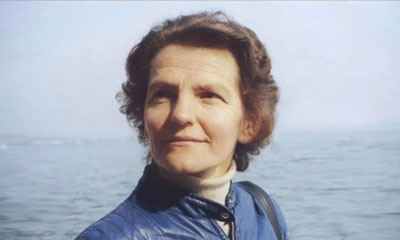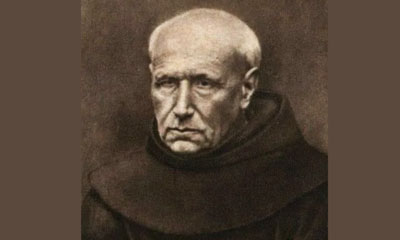October 2, 2024
Blessed Ann of Saint Bartholomew
Dear Friends,
“Anyone who has not begun to pray, I beg, for love of the Lord, not to miss so great a blessing. There is no place here for fear, but only desire… He will gradually gain a knowledge of the road to Heaven… Mental prayer, in my view, is nothing but friendly intercourse, and frequent solitary converse, with Him Who we know loves us,” wrote St Teresa of Ávila (Autobiography, ch. 8; cf. Catechism of the Catholic Church, no. 2709). By her teachings about prayer and by her example, the saintly reformer of the Carmelite Order raised up a multitude of saints. One of the first of these was Blessed Anne of St Bartholomew. She was a Carmelite nun, devoted to the love of God and neighbor. She opened her heart to all: to the great and the humble of this world, to soldiers and civilians, to cardinals and bishops, to the young and the old, to men and women, and especially to her Carmelite Sisters and Brothers.
 Anne García y Manzanas was born on October 1, 1549, in El Almendral, a village in Castile (Spain), as the sixth of seven children. Her parents formed a devout Christian couple and were well-to-do landowning farmers. Every Sunday, before Mass, they ministered to the poor, and the mother would visit the sick, caring for them with great compassion. The family always gathered for daily Mass, and also read the lives of the saints and prayed the Rosary together. Anne was just nine years old when her mother died in 1558. The following year, she also lost her father. From then on, her eldest brother and sister took the place of her parents. The material situation of the orphans began to deteriorate; Anne watched over the sheep, while the boys worked in the fields. Before long, Jesus made the young girl feel His presence, accompanying her in her life as a shepherdess.
Anne García y Manzanas was born on October 1, 1549, in El Almendral, a village in Castile (Spain), as the sixth of seven children. Her parents formed a devout Christian couple and were well-to-do landowning farmers. Every Sunday, before Mass, they ministered to the poor, and the mother would visit the sick, caring for them with great compassion. The family always gathered for daily Mass, and also read the lives of the saints and prayed the Rosary together. Anne was just nine years old when her mother died in 1558. The following year, she also lost her father. From then on, her eldest brother and sister took the place of her parents. The material situation of the orphans began to deteriorate; Anne watched over the sheep, while the boys worked in the fields. Before long, Jesus made the young girl feel His presence, accompanying her in her life as a shepherdess.
“She was naturally graceful, of medium height, and her face was charming,” Francisca, one of her cousins, later recalled. When Anne was old enough to marry, she was presented with her brother-in-law’s brother. But having already decided to give herself to God, she refused. In her early twenties, she confided her secret desire to become a nun to a priest who directed her to the Carmelite convent founded in Ávila by Mother Teresa of Jesus (St Teresa of Ávila). It was then that Anne revealed to her brothers her desire to become a cloistered nun. Despite their misgivings, they at last gave their consent, and the eldest, Hernando, brought her to the Carmelite convent. But she had to await permission from the superior, and Anne was forced to return to El Almendral for several months. She finally entered the Carmelite convent of St Joseph in Ávila at the beginning of November 1570. There, she could live totally for Christ and devote herself to the service of her Sisters.
This Carmelite convent had in fact been founded in 1562 by St Teresa. Doña Teresa de Ahumada (later known as St Teresa of Ávila), a brilliant and beautiful young girl born into a noble family of Castile, entered the Monastery of the Incarnation in Ávila in 1535 at the age of twenty. Having discovered the practice of mental prayer, she became dissatisfied with the somewhat easygoing way of life in the monastery. She also realized the evils from which the Church of her time was suffering: “At about this time there came to my notice the harm and havoc that were being wrought in France (because of Protestantism and the Wars of Religion)… This troubled me very much… I wept before the Lord and entreated Him to remedy this great evil. I felt that I would have laid down a thousand lives to save a single one of all the souls that were being lost there. And, seeing that I was a woman, and wretched, and incapable of doing all I should like in the Lord’s service, and as my whole yearning was, and still is, that, as He has so many enemies and so few friends, these last should be trusty ones, I determined to do the little that was in me—namely, to follow the evangelical counsels as perfectly as I could, and to see that these few nuns who are here should do the same” (The Way of Perfection, ch. 1). With this in mind, she founded the Carmelite convent of St Joseph of Ávila, where the Carmelites followed the primitive Rule of Carmel in its entirety, and led a life centered on prayer. Teresa attached great importance to solitude, enclosure and silence, so that nothing should distract the sisters from their searching for the Lord. Prayer is indeed greatly enhanced by silence.
The Catechism of the Catholic Church goes so far as to say: “Contemplative prayer is silence… or ‘silent love’ (St John of the Cross). Words in this kind of prayer are not speeches; they are like kindling that feeds the fire of love. In this silence, unbearable to the ‘outer’ man, the Father speaks to us his incarnate Word, who suffered, died, and rose; in this silence the Spirit of adoption enables us to share in the prayer of Jesus…Prayer is a communion of love bearing Life for the multitude, to the extent that it consents to abide in the night of faith” (CCC, nos. 2717, 2719).
“Go, My Daughter!”
It was in this Carmelite convent of St Joseph of Ávila, whose holy foundress was in fact often absent, that Anne was admitted. Before long, however, the peace and quiet of those early days disappeared. “It pleased our Lord to hide Himself from me and leave me in darkness,” she later wrote. This trial lasted throughout her novitiate. On taking the habit, the young novice was given the name of Anne of St Bartholomew. The convent was poor and still under construction: while the workmen ate their meals, the nuns would set to work themselves, and did what they could. Sister Anne of St Bartholomew also acted as porter, cook and nurse. On August 15, 1571, she made her religious profession as a lay sister, one who, in addition to prayer, was mainly assigned to manual tasks. From 1575 to 1577, she was struck by a strange illness: exhausted by her many tasks, she seemed close to death. The doctors were unable to identify her illness, and their remedies were ineffectual. On returning to St Joseph’s in Ávila towards the end of July 1577, St Teresa of Ávila called her to her side, restored her courage and then ordered her to go and feed the sick. Anne, who was in a critical state, obeyed, and Christ comforted her: she immediately felt better. The Mother told her: “Go, my daughter, be a good nurse… The Lord will assist you!”
Mother Teresa, who held Sister Anne of St Bartholomew in high esteem, wanted her to remain close to her at all times. From then on, they lived inseparably united until the Mother’s death. Anne surrounded her foundress with affection, keeping her company and helping her with the greatest promptitude. She would later candidly state that “Mother felt lost without her.” With the aim of establishing new monasteries, they made four long journeys together, in covered carts to preserve their enclosure, in the bitter cold of winter and the torrid heat of summer, along treacherous paths and despite the Mother’s ailments.
Teresa of Ávila’s motive for founding monasteries was her compassion for Christ who was suffering in his Church. In her “Relation” of February 9, 1570, she recounts a divine favor received at the Carmelite monastery of Malagón. The Lord caused her understand that He was currently undergoing great suffering in His body, the Church. “What can I do, Lord, to remedy so many ills?”, she asked: “‘I’m prepared to do anything!” Christ immediately replied: “This is no time for you to rest; make haste to found these monasteries; my joy is to be close to the souls who dwell in them.” At a time when the mystery of the Real Presence of Christ in the Eucharist was being especially rejected under the influence of Protestantism, Teresa was consumed with the desire to see new convents built where the Blessed Sacrament would be honored. Her vision of hell and the thought of the loss of souls also drove her to set up foundations to pray for the salvation of sinners.
Four Journeys with a Saint
The first journey made by the two nuns lasted from June to November 1579: they went to Medina, Valladolid, Alba de Tormes and Salamanca, before returning to Ávila. In Salamanca, in accordance with Mother Teresa’s wishes, Anne took up writing again, which she had learnt as a child; she used the saint’s handwriting as a model. She acted as secretary, copying Mother Teresa’s letters, and later perfected letters dictated on the spur of the moment. The second journey lasted from November of the same year to July 1580: they visited the community of Malagón and set up the new foundation of Villanueva de la Jara. During the third trip, from August 1580 to September 1581, they went to Medina and Valladolid, after which they set up foundations in Palencia and Soria. The fourth journey, from January to October 1582, was to be Mother Teresa’s last: it took them to Medina del Campo, Valladolid and Palencia, before reaching Burgos, where they founded a monastery on January 26, 1582, after a harrowing voyage. Mother Teresa was very ill. No sooner had the foundation in Burgos been completed than the house was suddenly flooded by a large swelling of the nearby river, and the nuns narrowly escaped death. On July 26, they set out for Ávila via Valladolid and Medina. There, Father Anthony of Jesus ordered them to go to Alba de Tormes, where they arrived on September 20. Two weeks later, Mother Teresa gave up her soul to God.
“On the afternoon of October 3, 1582,” Sister Anne would recount, “Father Anthony of Jesus went to visit the foundress, and seeing that I was not resting, he asked me to go and take some nourishment. And when I went, the saint didn’t calm down; she looked from one corner of the room to the other. And the Father asked her if she wanted me with her, and by signs she said yes, and they called me back. And as I came, as soon as she saw me she began to laugh; and she showed me so much thanks and love that she took me in her hands and put her head in my arms; and that’s how she remained clasped in my arms until she expired, and I was deader than the saint herself.”
Burning Zeal
Anne returned to Ávila on November 3, 1582. Mother Mary of St Jerome, a cousin of Mother Teresa, was elected prioress. One day, the Mother Foundress appeared to Sister Anne and told her that she could ask her whatever she wanted. She replied: “I ask you for the Spirit of God: may He always be in my soul!” Nine years later, in 1591, Mother Mary of St Jerome was elected prioress in Madrid for three years; she took Sister Anne of St Bartholomew with her. True to her calling to serve, Anne did her utmost to give joy and support to all the sisters, bringing a spirit of peace to the community in Madrid. The two nuns returned to Ávila in September 1594. But they soon left for another foundation in Ocaña, where they stayed for three years. The next four years were spent in Ávila in anticipation of a foundation in France. The heart of Sister Anne, having inherited the apostolic zeal of the foundress for the salvation of souls, burned with solicitude for those who were being lost in France.
Madame Acarie, a mystic and mother of six children, had made a habit of gathering men and women at her Parisian townhouse, including leading ladies of the court and academics eager to practice a demanding form of spirituality. In 1601, Madame Acarie began to read the writings of St Teresa. An apparition of St Teresa made her realize that she was called to found a Carmelite convent in France. To make sure that this new Carmel would be in tune with the spirit of the saint, the decision was made to turn to Spain to find nuns who had known the foundress. Pierre de Bérulle, who had founded the Oratoire de France, put a great deal of effort into this foundation, as did Michel de Marillac, who was to become Keeper of the Seals in 1626. The necessary arrangements were made over several years, but not without many difficulties, especially as relations between France and Spain were very strained. In addition, the Carmelite Fathers were reluctant to let the Sisters leave, and it took the intervention of the Apostolic Nuncio to overcome the Father General’s refusal.
On October 17, 1604, six Spanish Carmelite nuns arrived in Paris: Anne of Jesus, Isabel of the Angels, Beatrice of the Conception, Eleonor of St Bernard, Isabel of St Paul and a White Veil sister (i.e. a lay sister), Anne of St Bartholomew. A suitable accommodation had been prepared for them in the priory of Notre-Dame-des-Champs. Before long, seven French aspirants took the habit and began studying with the Spanish nuns, who impressed them by their holiness and their human qualities. Anne of St Bartholomew immediately set to work in her humble service of the kitchen. Her ideal was obedience; she would later write: “We have nothing better to give God than our will. He sets the same store by the little things done through obedience as He does by the big things, because He does not consider the greatness of them, but the love we bring to them and our self-denial.”
The Great Silence
Very soon, having recognized the merits and abilities of Sister Anne of St Bartholomew, the superiors of the Order compelled her to leave her status as a lay sister to become a choir sister (a desire that Mother Teresa had already expressed during her lifetime, but which Sister Anne had resisted in order to remain in the humblest state). She was then appointed prioress of a monastery founded in Pontoise in January 1605. Anne devoted herself completely to the teaching of the Teresian charism, in particular the practice of silence. “Let us see in His Majesty (God) one thing to admire, out of all His other actions: the great silence with which He performed all the mysteries of our Redemption. Following His example, let us keep our silence for His love. Let us do our works for Him alone, in silence; that is the most important thing. Our Lord himself says that He will speak in secret to the humble of heart,” she wrote, adding: “Blessed silence! In it, you cry out and preach to the whole world by your example. There is more wisdom to be learned from it by those who love you than from books or study. Our Lord became a spring of Living water for us so that we should not die of thirst among all the miseries that surround us. Without faith, we cannot follow that royal road of the divine mysteries. It is faith that opens our eyes and makes us see the truth; and where faith is wanting there is no light and no way leading to goodness.”
However, on the following October 5, she was chosen to become prioress of the community in Paris. She fled Pontoise at two o’clock in the morning, in absolute secrecy and under disguise, so that no one in the community or in the city could prevent her from leaving. There was only one professed nun in her new community, but there were many novices. Mother Anne devoted herself entirely to the task of establishing a family inflamed with the love of Christ. To her great satisfaction, and despite the language barrier, a beautiful fraternity blossomed. She desired to live under the government of the Carmelite Fathers, but was not allowed to do so. Before long, Pierre de Bérulle began meddling with the life of the community and unwittingly sowed the seeds of trouble by not allowing the prioress to fulfil her role. This caused Mother Anne great suffering. On May 18, 1608, she was sent to Tours in order to found a Carmelite convent. The social and religious situation in that city differed from that in Paris. Although the monastery escaped the influence of Pierre de Bérulle, many Protestants resented the arrival of the Carmelite nuns and spoke ill of them. However, Mother Anne succeeded in reversing the situation: she made herself respected and even obtained a few conversions. “These Teresian nuns that we don’t like,” people murmured, “are going to convert us all to the faith.” The work accomplished by Mother Anne of St Bartholomew in France was considerable: the editor of Cardinal de Bérulle’s letters states that “in the history of Catholic restoration in France, she deserves a place that historians have not yet ascribed to her.”
Mother Anne wrote a great many letters that were always both spontaneous and straightforward, brimming with affection but also remarkably prudent. She always showed concern for others, in particular regarding their health, because she could not bear to see them suffer; many of her letters revealed her desire to inspire others with courage and joy. Anne was a vibrant woman who, as she herself would say, never allowed anyone to be sad.
By Love and Example
Over time, Mother Anne of St Bartholomew abandoned all hope of living under the jurisdiction of the Carmelite Fathers in France: Pierre de Bérulle was standing in her way. At the suggestion of the Carmelites in the Netherlands and with the authorization of Father General, she left for Antwerp, in Flanders, which was under Spanish rule at the time. On November 6, 1612, the foundation took place amid great poverty, but with immense trust in Providence, following the way of St Teresa. Three years later, the small community relocated to its permanent convent. Mother Anne applied the Teresian pedagogy, expecting purity and simplicity, obedience and total openness. “If you guide them (the novices) with prudence and love,” she wrote, “you will convince them to regard bitterness as sweetness. It is good to speak to them with frankness, and to tell them on occasion about our own faults or some of our temptations, so as to give them the courage to admit their own. If we teach virtue in words, lest we show it in deeds, we teach it badly. The full demands of religious life can be shown better by love and example than by harshness and threats.” Indeed, her rule recommended: “The prioress shall follow the law of gentleness and shall only be severe and rigorous in exceptional circumstances.” In the same spirit, Mother Anne was wont to pray: “Lord, if you must chastise me, I would rather be chastised for too much gentleness than for too much severity.” Yet she did not lack the necessary firmness when it came to God’s clear will. She herself lived in an austere manner and slept about three hours a night. But her mortifications had humility as their goal: “External mortification will be of little use to you,” she told her Sisters, “if it is not governed by interior humility and mortification… Let us walk in the fear of God and in saintly humility. God immediately forgives errors committed out of sheer weakness, but lukewarmness in love, especially when it is persistent, displeases him very much.”
When Mother Anne arrived, Flanders still enjoyed peace. The “Eighty Years’ War” (1568–1648), an insurrection by a section of the Dutch population, especially Protestants, against the Catholic King of Spain and sovereign of the Netherlands, had indeed been suspended by a twelve-year truce established by the Treaty of Antwerp (1609). When the truce came to an end, hostilities resumed. On the night of October 13-14, 1624, the city of Antwerp suffered a surprise attack by the Protestants, from the sea. Although it was night, the prioress gathered her sisters to pray, and a storm scattered the ships and foiled the attackers’ plans. All attributed this liberation to the prayers of Anne of St Bartholomew.
During the last two years of her life, Mother Anne suffered from several illnesses. On February 7, 1626, four months before her death, she had a vision of the Most Holy Trinity. Several ladies of the Court came to visit the ailing nun. Dismayed by this excess of attentions, she addressed the Lord: ‘How can you tolerate that a poor Carmelite nun should make such commotion? No, Lord, do not allow it, but take me without noise or fuss! A poor Carmelite should not make so much noise at her death!” On June 7, the Sunday of the Most Holy Trinity, her death caught her friends and the grandees of the Court by surprise. Mother Anne was seventy-six years old.
Mother Anne of St Bartholomew was beatified by Pope Benedict XV on May 6, 1917. Let us ask her to obtain for us faithfulness to daily prayer, and burning zeal for the salvation of souls!








